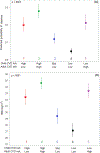Life course trajectories of cardiovascular risk: Impact on atherosclerotic and metabolic indicators
- PMID: 30453117
- PMCID: PMC7521150
- DOI: 10.1016/j.atherosclerosis.2018.11.008
Life course trajectories of cardiovascular risk: Impact on atherosclerotic and metabolic indicators
Abstract
Background and aims: In this analysis, we estimated population-level trajectory groups of life course cardiovascular risk to explore their impact on mid-life atherosclerotic and metabolic outcomes.
Methods: This prospective study followed n = 1269 Bogalusa Heart participants, each with at least 4 study visits from childhood in 1973 through adulthood in 2016. We used discrete mixture modeling to determine trajectories of cardiovascular risk percentiles from childhood to adulthood. Outcomes included mid-life subclinical atherosclerotic measures [(carotid intima-media thickness (cIMT), pulse wave velocity (PWV)], metabolic indicators [(diabetes and body mass index (BMI)], and short physical performance battery (SPPB).
Results: Between the mean ages of 9.6-48.3 years, we estimated five distinct trajectory groups of life course cardiovascular risk (High-Low, High-High, Mid-Low, Low-Low, and Low-High). Adult metabolic and vascular outcomes were significantly determined by life course cardiovascular risk trajectory groups (all p < 0.01). Those in the High-Low group had lower risks of diabetes (20% vs. 28%, respectively; p = .12) and lower BMIs (32.4 kg/m2vs. 34.6 kg/m2; p = .06) than those who remained at high risk (High-High) throughout life. However, the High-Low group had better cIMT (0.89 mm vs. 1.05 mm; p < .0001) and PWV (7.8 m/s vs. 8.2 m/s; p = .03) than the High-High group. For all outcomes, those in the Low-Low group fared best.
Conclusions: We found considerable movement between low- and high-relative cardiovascular risk strata over the life course. Children who improved their relative cardiovascular risk over the life course achieved better mid-life atherosclerotic health despite maintaining relatively poor metabolic health through adulthood.
Keywords: Atherosclerosis; Epidemiological methods; Life course cardiovascular risk; Metabolic disease; Trajectory analysis.
Copyright © 2018 Elsevier B.V. All rights reserved.
Conflict of interest statement
Conflicts of interest
The authors declared they do not have anything to disclose regarding conflict of interest with respect to this manuscript.
Figures



References
-
- Katzmarzyk PT, Perusse L, Malina RM, Bergeron J, Despres JP, Bouchard C. Stability of indicators of the metabolic syndrome from childhood and adolescence to young adulthood: the Quebec Family Study. J Clin Epidemiol. February 2001;54(2):190–195. - PubMed
-
- Yusuf S, Hawken S, Ounpuu S, et al. Effect of potentially modifiable risk factors associated with myocardial infarction in 52 countries (the INTERHEART study): case-control study. Lancet. September 11 2004;364(9438):937–952. - PubMed
-
- Berenson GS, Bogalusa Heart Study I. Bogalusa Heart Study: a long-term community study of a rural biracial (Black/White) population. The American journal of the medical sciences. November 2001;322(5):293–300. - PubMed
Publication types
MeSH terms
Grants and funding
LinkOut - more resources
Full Text Sources
Medical

